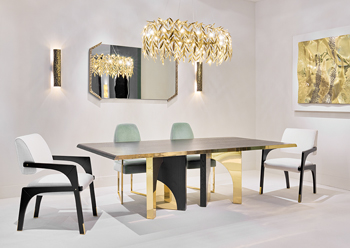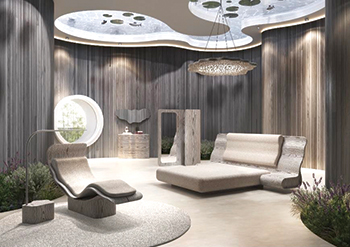What's new
01 November 2019
Back to nature with Natuzzi
Italian furniture brand Natuzzi Italia showcased Ergo, the latest bedroom collection designed by Ross Lovegrove at the recent London Design Festival 2019. Demonstrating the brand’s evolutionary journey, Ergo includes a bed, chaise-longue, chandelier, valet stand, chest of drawers, floor lamp, rug and mirror, which have been made without the use of lead-based paints. Each element draws on the surfaces and motifs of nature and is designed to be the perfect companion for everyday living.
Recognising the seamless fusion of excellent design and distinct aesthetics, the collection has been distinguished with the Red Dot under the Furniture category at the Red Dot Award for Design Concept 2019.
Ergo uses responsibly-sourced, renewable and recyclable materials, including FSC (Forest Stewardship Council)-certified wood from sustainably-managed forests, according to a spokesman for the Italian company. “Its components interlock seamlessly, so that each piece can be put together with no need for metal parts or screws. The water-based adhesives used are formaldehyde-free. All finishes are made with natural wax. The only metal used is aluminium,; the textile fibres used for the upholstery are linen, wool and cotton; and the mattress is in 100 per cent natural latex.
 |
|
Rygalik with the chair. |
Red oak chair is Natural Born
The American Hardwood Export Council (AHEC), the leading trade association for the American hardwood industry, has collaborated with Tomek Rygalik of Studio Rygalik, and a Polish furniture production and design studio Swallow’s Tail Furniture, to develop a chair where American red oak is the focus of its simple yet aesthetic design.
Rygalik started his conceptual work from scratch by exploring the material and its potential - not only in terms of aesthetics, but also functionality. The chair aims to present a new way of thinking about design. It is a deliberate departure from over-complicated design, which often isn’t related to the product’s final function.
Speaking of the pressing need to design sustainably, Rygalik says he saw enormous potential in American red oak from factors such as where it’s grown: a tree’s place of origin can change its colour and grain, or how the timber is finished.
“The simple yet diverse characteristics of the red oak boards have been inspirational for me. Instead of searching for and later imposing an imaginary form, I was thinking about the shortest way to process the material from the forest – that is, its place of origin, to the finished product. Basic wooden pieces in the form of simple boards create a fully functional solution. I wanted the chair design to not require a lot of energy and man-hours. The Natural Born chair is a simple, durable, comfortable and fully natural piece of furniture with a very low carbon footprint,” says Rygalik.
 |
|
Utopia table paired with the Arches chairs. |
Utopian designs
InsidherLand of Portugal has introduced its Utopia dining table and Arches chair as part of its Identity collection to reflect the key characteristics of an ideal city.
“Since the Renaissance, many attempts have been made to develop ideal cities,” says a spokesman for InsidherLand. “The new cities were planned in rational and geometric styles, trying to reflect the new habits and evolution of societies. However, due to their complexity, the vast majority of them failed to transpose the theoretical idealisations of a utopian urbanism.”
Reflecting the city that never was, the Utopia table is designed in the likeness of the architectural scale that suggests a cross-section through the structures of a utopian city, organised by the principles of symmetry and ideal forms. Two brass blades stylise the dark oak top, curving it with an avant-garde detail. In its base lies a passageway between four apparently identical arches, two of which stand impassable as symbols of discontent and visual imperfection.
Meanwhile, the Arches dining chair complement the Utopia table and in line with the theme explored by it, recreates the design of its arches crossed on different levels. The raised backrest stands out from the remaining set that only crosses in a single point, whereas a folded brass bar rises as a support element that prevents the contact of the arches with the floor.



